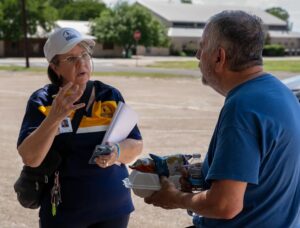
WASHINGTON (BP)–The U.S. Supreme Court announced June 28 it would not review another lower-court decision on a Ten Commandments display, a day after it issued split rulings on public exhibits of the Decalogue that critics said did little to clarify the issue.
The court also revealed it would rule on an abortion protest case that returned to the high court after justices had appeared to settle whether a federal anti-racketeering law could be used against pro-life demonstrators in a 2003 opinion.
In rejecting the Ten Commandments case, the Supreme Court allowed to stand a decision by the Sixth Circuit Court of Appeals in Cincinnati that a display outside schools in that state’s Adams County violated the First Amendment’s prohibition on government establishment of religion. The schools had first permitted Ten Commandments monuments donated by a local ministerial alliance to be placed in front of four new schools, but other monuments, also funded by private sources, later were added to the displays. These stones included excerpts from the Declaration of Independence and the preamble to the Constitution.
The Ohio displays in Adams County v. Baker had some similarities to the displays in both cases decided June 27.
The high court ruled that Kentucky county courthouse displays of the Ten Commandments among groupings of other historical documents, such as the Declaration of Independence and Constitution, infringed the establishment clause. While the displays in that case were government-sponsored, the Ten Commandments monument upheld as constitutional by the justices in another opinion the same day was privately donated more than 40 years before. The court-approved display was a stand-alone granite monument on the grounds of the Texas state capitol.
The court voted 5-4 in both cases, and critics said the results would include disorder and many lawsuits.
While the decision on the Texas display provides for thousands of similar monuments to “remain in place across the country,” the Kentucky-related opinion “will create additional confusion in this area of the law,” said Chief Counsel Jay Sekulow in a commentary on the American Center of Law and Justice website.
R. Albert Mohler Jr., president of Southern Baptist Theological Seminary in Louisville, Ky., said, “At the end of the day, the real winners were the lawyers, who can look forward to a tidal wave of litigation in the aftermath of these confusing decisions.”
The rulings “settled very little,” Mohler wrote in a commentary on his website. “The court established no clear test for determining the constitutionality of Ten Commandments displays, and the contorted and shifting arguments contained in the various written opinions offer what can only be described as contradictory principles.”
Ten Commandments displays are “no substitute for the church’s responsibility to teach and preach the Word of God and to bear witness to the Gospel of the Lord Jesus Christ,” Mohler wrote. “Nevertheless, we must understand that these decisions, taken together, represent more government hostility toward religious expression –- even in the form of a public acknowledgment of the historical significance of the Ten Commandments.”
Paige Patterson, president of Southwestern Baptist Theological Seminary in Fort Worth, Texas, said in a written statement for Baptist Press that the ruling on the Kentucky courthouse displays constitutes “another tragic step in the continuing saga of judicial usurpation of the religious freedoms upon which our country was founded.”
“With few law schools focusing on the philosophy of law, it is perhaps understandable that five of the Supreme Court justices basked in total ignorance of the philosophy of law; however, it seems to me unforgivable that those five Supreme Court justices should also be ignorant of history and the commitments that our Founding Fathers held so dear,” Patterson said. “[The] decision not only further erodes religious liberty in America, but also paves the way for a plethora of new lawsuits contesting every conceivable expression of the faith of our Founding Fathers.”
The high court’s decision to review lower-court action in the pro-life protest case gives it an opportunity to deal with a recalcitrant appeals court. In 2003, the justices decided in an 8-1 ruling that the Racketeering Influenced and Corrupt Organizations Act (RICO) did not apply to protest activities at abortion clinics. The pro-life demonstrators did not commit extortion, the justices ruled, sending the case back to the Seventh Circuit Court of Appeals. The Seventh Circuit, however, ruled that a nationwide injunction against the protestors should remain in place under RICO.
The Supreme Court “has a critically important opportunity to remove a dark cloud that has been hanging over the pro-life movement for nearly 20 years,” the ACLJ’s Sekulow said in a written statement. “By taking this case now, we are hopeful the high court will move to vindicate these pro-life demonstrators once and for all.”
ACLJ represents Operation Rescue in the case. The twin cases, Operation Rescue v. National Organization for Women and Scheidler v. NOW, will be consolidated and argued before the high court after its new term begins in October.
The cases began in 1986 with suits by NOW.
They are primarily free-speech cases, and activists from across the political spectrum have sided with the pro-life demonstrators. Among those signing on to friend-of-the-court briefs supporting the pro-lifers were actor Martin Sheen, anti-war priest Daniel Berrigan and anti-death penalty activist Helen Prejean, as well as People for the Ethical Treatment of Animals.
–30–














